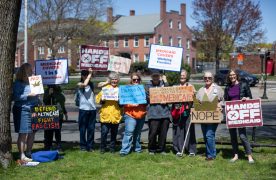When nature calls, Bostonians will no longer be forced to sneak into a restaurant or store and pretend they are going to buy something.
Since several state-of-the-art public pay toilets have hit the pavement, Boston is looking even more European. The latest toilet is situated right in the middle of Copley square. But casual observers may have missed the new facilities because their sleek, ultra-modern designs make them fit right into the urban landscape.
“We just went over the 100,000 flush mark,” said Peter O’Sullivan, director of the Street Furniture Program that is responsible for installing the toilets. “The one near the aquarium is the most frequently used one of its kind in the world.”
These loos are unlike any other public restroom. A mere 25 cents opens the door for up to 25 minutes of use in the spaceship-like contraption. Not to be confused with a port-a-potty, one of Boston’s new toilets could guest star on “Star Trek.”
Brightly lit, it is self-cleaning and smells fresh after every use – the floor caves in and water washes over it and the toilet. It is also outfitted with a large mirror, a sensor-activated hand-dryer, water faucet and soap dispenser. The cans are roomy enough to be accessible to the handicapped, and loud, electronic music bounces off the spotless white walls and stainless steel accents.
Five of the toilets have been installed under the Street Furniture Program, along with 13 telephone pillars, 164 bus shelters, 71 city information panels and three map pillars, and more furniture is on the way.
In 2001, Boston signed a 20-year contract with Wall USA, Inc., a subsidiary of Wall AG, a German street furniture company with products in 57 cities around the world, including Istanbul, Moscow and Dsseldorf, Germany. Wall provides the furniture for free, in return for the right to sell advertising space on it to businesses. The city also receives some of the ad revenue and will get a check from Wall for more than $1 million this year, according to O’Sullivan.
“People love this stuff, and it makes huge money,” O’Sullivan said. “The money goes into a general fund and is used to fund different things. We use a lot of the money for things that have been cut out of the state budget.”
Maintenance workers from Wall inspect and clean the toilets three times a day. Boston police also monitor the toilets to make sure drug users or homeless people are not using them as hangouts and to make sure only one adult enters at a time, so people do not use them for sexual escapades, O’Sullivan said. The toilets close at 10 p.m. and have emergency 911 buttons.
Internationally renowned German architect Joseph Paul Kleihues designed the “streetline” model specifically to fit Boston’s character. After landing the contract, Wall built a new production facility in South Boston to build and assemble all of the city’s street furniture.
Wall USA President Martin McDonough said that three more of the $250,000 toilets are waiting in the factory, but the installation sites have yet to be determined.
“We have to undergo a long process of community review and apply for permits before installing them,” McDonough said.
A toilet may be installed in Kenmore Square after planned construction on Commonwealth Avenue is finished, McDonough and O’Sullivan said. McDonough added that Wall just landed a new contract to install street furniture outside of Logan Airport, and is looking to continue to expand in the Boston-area, as well as possibly move into New York City, McDonough said.
Last Saturday, as thousands of pedestrians passed the public toilet in Copley Square, many eyes were obviously drawn to it, and several people slowed down to check it out. But not one person stopped to use it in an hour, although several used the adjacent pay phones.
Many pedestrians said they would take advantage of the public toilet in an emergency.
“Sure, I would use it, if I had to. I mean I’d rather spend 25 cents than be forced to buy something that I didn’t want at a store or restaurant, just to be able to use their toilet,” said Boston resident Katherine McDonald.
But others doubted the toilet would live up to its promises of cleanliness and said they wouldn’t need to use it because they could just go into a local businesses and go to the bathroom for free.
“I doubt it is that clean and I don’t think the city needs even more advertisements around,” said Boston resident Jean Carpenter.
O’Sullivan said that the toilet was especially popular with visitors and business-owners during the recent Patriots Super Bowl victory parade.
“A lot of business owners are happy with it.” O’Sullivan said. “During these big events, they don’t want people just coming in to use the bathroom when they aren’t going to buy anything.”
But several Boston University students said they had not even noticed the new public toilets. Some said that they would be more likely to use a restaurant or library bathroom instead but might resort to a pay-toilet in an emergency.
“I guess I would use them, but only if I had heard good things about them and they were clean,” said College of Arts and Sciences freshman Deanna Tocco.
But College of Communication sophomore Noanna Tzinakos said the urge to go would make her use the toilet.
“I might use them if I really had to,” Tzinakos said. “When you gotta go, you gotta go.”
This is an account occasionally used by the Daily Free Press editors to post archived posts from previous iterations of the site or otherwise for special circumstance publications. See authorship info on the byline at the top of the page.













